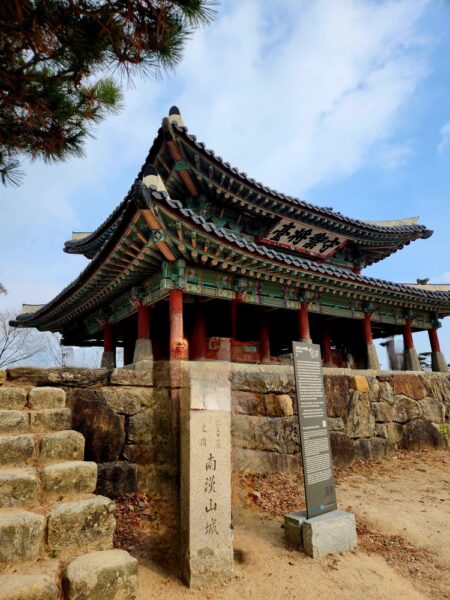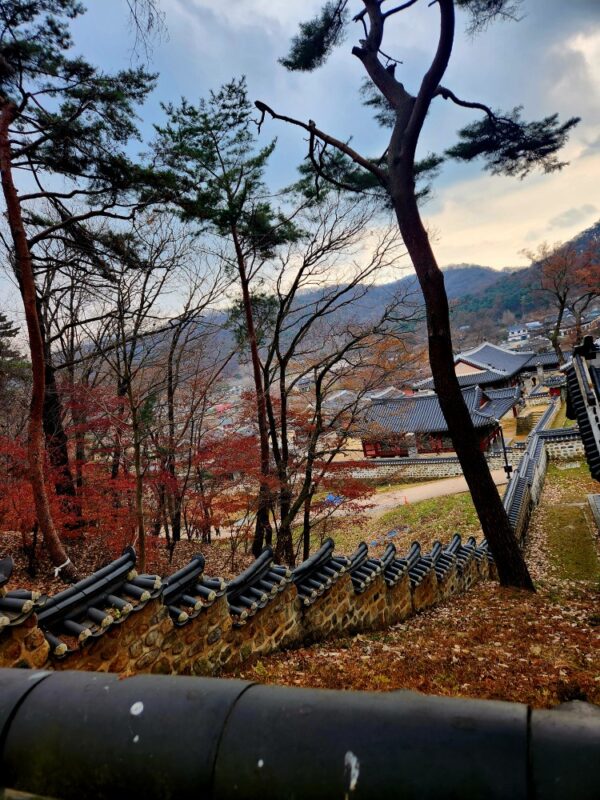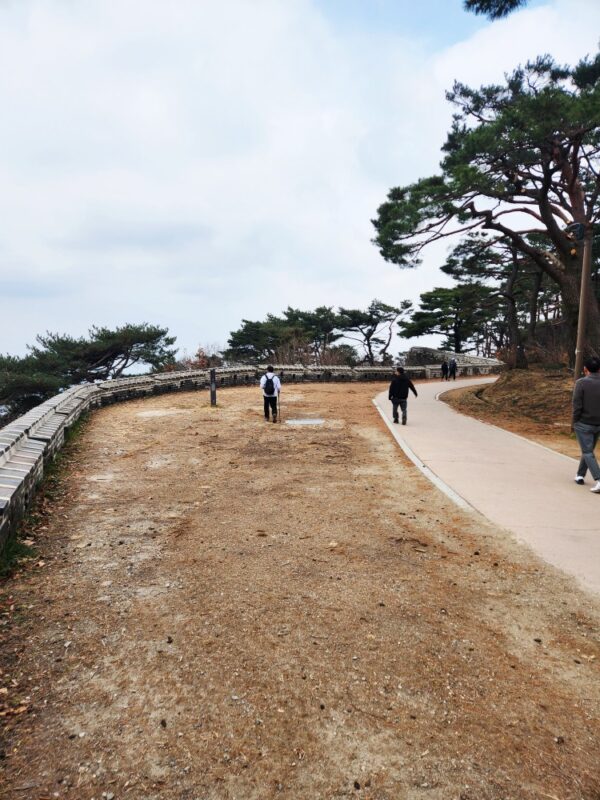🟧 Namhansanseong Autumn Guide — 5 Scenic Courses in One Visit (UNESCO World Heritage Site)
Just 1 hour from Seoul: fortress walls, history, and brilliant fall colors.
🍁 1. Namhansanseong at a Glance
Located just an hour from Seoul, Namhansanseong is a UNESCO World Heritage fortress surrounded by stunning fall foliage.
✔️ Key Highlights
- 📍 Location: Namhansanseong-myeon, Gwangju-si, Gyeonggi-do
- 🏛 UNESCO: Inscribed in 2014
- 🍂 Peak Foliage: Late October – Mid November
- 🚶♀️ Trails: 5 courses (2.8 km – 7.7 km)
- 💸 Admission: Free for Gyeonggi residents / Adults KRW 2,000
- 🚗 Parking: KRW 3,000 weekdays / KRW 5,000 weekends
- ⏰ Hours: Apr–Oct: 10:00–18:00 / Nov–Mar: 10:00–17:00
- ❗ Closed: Mondays
Namhansanseong Autumn Guide
🌏 Before You Head Out
Before you head out, make sure to download the Naver Map app — it’s the most accurate navigation app in Korea.
Unlike Google Maps, which often struggles with Korean addresses and routes, Naver Map provides precise walking, driving, and public transport directions in English.
Available on both Android and iOS, it’s your best companion for navigating anywhere in Korea, whether you’re looking for hospitals, clinics, pharmacies, government offices, tourist attractions, restaurants, or simply getting around the city.
👉 Download Naver Map (Google Play) | App Store
🟩 2. Why Namhansanseong’s Autumn Foliage Is Special
Namhansanseong is where Korean history, military strategy, and breathtaking autumn landscapes come together. Historic gates, stone walls, and temples appear and disappear between waves of red and golden foliage—often described as the “purest form of Korea’s autumn scenery.”
🟩 3. Quick Comparison of All 5 Trails
| Course | Distance | Duration | Difficulty | Highlights |
|---|---|---|---|---|
| Jangsu Trail | 3.8 km | 1 hr 20 min | ★☆☆ | 3 gates |
| King’s Trail | 2.8 km | 1 hr | ★☆☆ | King Injo’s path |
| Monk-Soldiers’ Trail | 5.7 km | 2 hrs | ★★☆ | Janggyeongsa, Bongamseong |
| Ongseong Trail | 3.8 km | 1 hr 20 min | ★★☆ | South Ongseong |
| Fortress Trail | 7.7 km | 3 hrs 20 min | ★★★ | Panoramic views |
🌿 4. Trail-by-Trail Breakdown – Namhansanseong Autumn Guide
① Jangsu Trail (3.8 km / 1 hr 20 min)
- Jeonseungmun (North Gate) -> Uikmun (West Gate) -> Secret Gates & Sueojangdae Pavilion -> Jihwamun (South Gate)
Course 1, the Jangsu Trail, is the most popular hiking route in Namhansanseong. It stretches about 3.8 km and takes roughly 1 hour and 20 minutes. The path is gentle and beginner-friendly, yet the military relics scattered along the way make the entire walk feel like stepping back into history.
As you follow the fortress wall, you’ll pass the North Gate (Jeonseungmun), the West Gate (Uikmun), and the South Gate (Jihwamun). Between these gates are secret side gates once used for urgent wartime communication, along with Sueojangdae Pavilion—the former command headquarters. Despite the short distance, the trail vividly reflects Joseon’s defensive system and military strategies.
For anyone wanting an easy walk where nature and history blend seamlessly, the Jangsu Trail is the perfect starting point for exploring Namhansanseong.
② King’s Trail (2.8 km / 1 hr)
- Sanseong Rotary-> Yeongwoljeon Pavilion -> Sungryeoljeon Pavilion -> Seomun (West Gate) -> Sueojangdae Pavilion -> Gukcheongsa Temple->Sanseong Rotary
The second route, “King’s Trail,” is about 2.8 km long and takes roughly one hour to complete. It’s the shortest of Namhansanseong’s five trails, but its story is far from light. This path is known as the route King Injo walked to surrender during the Qing invasion of Joseon, carrying the weight of the dynasty’s pain and difficult decisions.
As you follow the neatly maintained pine forest trail, the walls fade into the background and the forest becomes the main scenery, blocking out all traces of the city. In autumn, red foliage drapes over the fortress stones, and in winter, snow settles between the gates, creating a quiet, almost solemn landscape.
This short trail, with its heavy historical significance, often leaves the deepest impression. For those seeking a gentle walk or a moment of reflection in peaceful nature, the “King’s Trail” offers one of the most delicate and meaningful stories Namhansanseong has to share.

③ Monk-Soldiers’ Trail (5.7 km / 2 hrs)
- Namhansanseong World Heritage Center → Beolbong Peak → Janggyeongsa Temple → Mangwolsa Temple → East Gate → Jisudang → Namhansanseong World Heritage Center
If you want to experience Namhansanseong on a deeper level, try Course 3, “Monk-Soldiers’ Trail.” Stretching about 5.7 km and taking roughly 2 hours, this route goes beyond a simple hike—it follows the footsteps and spirit of the Joseon-era monk-soldiers.
Along the way, you’ll pass Janggyeongsa Temple and Bongamseong Fortress. Janggyeongsa served as a base where monk-soldiers stayed and carried out military duties during the Byeongja Horan (the Qing invasion of Joseon (1636), illustrating how Buddhist principles became intertwined with national defense.
Bongamseong, an outer defensive stronghold of Namhansanseong, is notable for its construction that takes full advantage of the mountain’s natural terrain.
④ Ongseong Trail (3.8 km / 1 hr 20 min)
- Sanseong Rotary → Namjangdae Site → East Gate → Jisudang → Gaewonsa Temple → Sanseong Rotary
Course 4, “Ongseong Trail,” is about 3.8 km long and takes roughly 1 hour and 20 minutes. As the name suggests, the highlight of this route is the South Ongseong—an outer defensive wall built in front of the main gate to block enemy attacks, showcasing the strategic military planning of the Joseon dynasty.
This trail blends fortress walls with forest paths, offering different scenery in every season. In autumn, the foliage colors the stone walls, while in winter, snow settles quietly over the gate, creating a serene and timeless atmosphere.
⑤ Fortress Trail (7.7 km / 3 hrs 20 min)
- East Gate → North Gate → West Gate → South Gate → back to the East Gate
The final Course 5, “Fortress Trail,” is the longest route in Namhansanseong, stretching about 7.7 km and taking roughly 3 hours and 20 minutes to complete. As you follow the fortress walls, the panoramic views of Seongnam, Hanam, and Gwangju change constantly, revealing why Namhansanseong is often called “the fortress made by the sky.”
Though it’s a long trek, this trail allows you to truly feel the full outline and scale of Namhansanseong. Once a strategic Joseon-era stronghold and now a UNESCO World Heritage Site, its grandeur is best experienced along this course.
Namhansanseong Autumn Guide
🟨 5. Useful Tips for Your Visit
✔️ Visit early during peak foliage
Parking fills fast; arrive before 10 AM.
✔️ Which trail should you choose?
- Easy → Jangsu-gil / King’s Road
- Best photos → Jangsu-gil / Ongseong Road
- History-focused → Monk-Soldiers’ Road
- Full experience → Fortress Road
✔️ Clothing
Wind is stronger along the fortress walls—bring a windbreaker.
🟥 6. Private Tour Options
Seoul Namhansanseong Fortress Walking Tour (Klook)
Namhansanseong UNESCO Sites + Korean Folk Village Private Tour
💛 7. Namhansanseong History — Why UNESCO Recognized It
1) Built as Seoul’s Final Line of Defense
Namhansanseong was fully developed in 1624 during the reign of King Injo.
It was built for several strategic reasons:
Joseon needed an emergency capital to protect Hanyang (Seoul).
Military pressure from the Later Jin/early Qing was increasing.
The state required a fortified city that combined fortress walls, a palace, temples, and military facilities.
As a result, Namhansanseong became the centerpiece of Joseon’s national defense strategy.
If Seoul was attacked, the king and government would retreat to this mountain fortress and continue leading the war.
In other words, Namhansanseong was not just a stone wall — it was the core of a national emergency system designed to safeguard the kingdom in times of crisi
2) Center of the 1636 Qing Invasion
King Injo resisted for 45 days inside the fortress.
- Haenggung (temporary palace)
- Ammun (Secret gates)
- Sueojangdae Command Pavilion
Namhansanseong Autumn Guide
3) A Complete Fortress City
- Government offices (Temporary Palaces)
- Military garrisons (Sueocheong, Chongyungcheong)
- Temples with monk-soldiers (Janggyeongsa Temple and Bongamsa Temple)
- Wells, warehouses, homes
4) UNESCO Criteria (2014)
📌 (1) An outstanding example of East Asian mountain fortress culture
A unique defensive structure built in perfect harmony with the surrounding mountains and natural terrain.
📌 (2) A fully preserved defensive capital system of the Joseon Dynasty
A rare case where the king, military, religious institutions, and civilians all functioned together as a single fortified city.
📌 (3) Directly associated with major historical events
A site that witnessed the Qing invasion, national crisis, and the king’s resistance — serving as a powerful testament to the weight of history.
5) Walking Through 400 Years of History
Every gate, trail, and wall still carries traces of Korea’s past.
10. Next Destinations
Gwanaksan & Namhansanseong 2025: Inspiring Autumn Trails for a Magical Fall Journey
11. Affiliate Disclosure
Some links in this post are affiliate links. If you make a purchase through them, Lucia’s Travel Studio may earn a small commission at no extra cost to you. Thank you for supporting this travel content!



